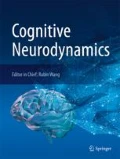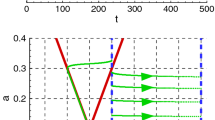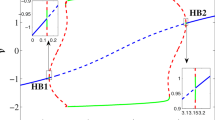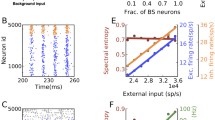Abstract
We are interested in characterization of synchronization transitions of bursting neurons in the frequency domain. Instantaneous population firing rate (IPFR) \(R(t)\), which is directly obtained from the raster plot of neural spikes, is often used as a realistic collective quantity describing population activities in both the computational and the experimental neuroscience. For the case of spiking neurons, a realistic time-domain order parameter, based on \(R(t)\), was introduced in our recent work to characterize the spike synchronization transition. Unlike the case of spiking neurons, the IPFR \(R(t)\) of bursting neurons exhibits population behaviors with both the slow bursting and the fast spiking timescales. For our aim, we decompose the IPFR \(R(t)\) into the instantaneous population bursting rate \(R_b(t)\) (describing the bursting behavior) and the instantaneous population spike rate \(R_s(t)\) (describing the spiking behavior) via frequency filtering, and extend the realistic order parameter to the case of bursting neurons. Thus, we develop the frequency-domain bursting and spiking order parameters which are just the bursting and spiking “coherence factors” \(\beta _b\) and \(\beta _s\) of the bursting and spiking peaks in the power spectral densities of \(R_b\) and \(R_s\) (i.e., “signal to noise” ratio of the spectral peak height and its relative width). Through calculation of \(\beta _b\) and \(\beta _s\), we obtain the bursting and spiking thresholds beyond which the burst and spike synchronizations break up, respectively. Consequently, it is shown in explicit examples that the frequency-domain bursting and spiking order parameters may be usefully used for characterization of the bursting and the spiking transitions, respectively.




Similar content being viewed by others
References
Batista CAS, Batista AM, de Pontes JAC, Viana RL, Lopes SR (2007) Chaotic phase synchronization in scale-free networks of bursting neurons. Phys Rev E 76:016218
Batista CAS, Lameu EL, Batista AM, Lopes SR, Pereira T, Zamora-Lopez G, Kurths J, Viana RL (2012) Phase synchronization of bursting neurons in clustered small-world networks. Phys Rev E 86:016211
Belykh I, de Lange E, Hasler M (2005) Synchronization of bursting neurons: what matters in the network topology. Phys Rev Lett 94:188101
Bloomfield P (2000) Fourier analysis of time series: an introduction, 2nd edn. Wiley, New York, p 261
Börgers C, Kopell N (2003) Synchronization in network of excitatory and inhibitory neurons with sparse, random connectivity. Neural Comput 15:509–538
Börgers C, Kopell N (2005) Effects of noisy drive on rhythms in networks of excitatory and inhibitory neurons. Neural Comput 17:557–608
Brunel N (2000) Dynamics of sparsely connected networks of excitatory and inhibitory spiking neurons. J Comput Neurosci 8:183–208
Brunel N, Hakim V (1999) Fast global oscillations in networks of integrate-and-fire neurons with low firing rates. Neural Comput 11:1621–1671
Brunel N, Hakim V (2008) Sparsely synchronized neuronal oscillations. Chaos 18:015113
Brunel N, Hansel D (2006) How noise affects the synchronization properties of recurrent networks of inhibitory neurons. Neural Comput 18:1066–1110
Brunel N, Wang XJ (2003) What determines the frequency of fast network oscillations with irregular neural discharges? J Neurophysiol 90:415–430
Buzsáki G (2006) Rhythms of the brain. Oxford University Press, Oxford
Coombes S, Bressloff PC (eds) (2005) Bursting: the genesis of rhythm in the nervous system. World Scientific, Singapore
Dhamala M, Jirsa V, Ding M (2004) Transitions to synchrony in coupled bursting neurons. Phys Rev Lett 92:028101
Duan L, Fan D, Lu Q (2013) Hopf bifurcation and bursting synchronization in an excitable systems with chemical delayed coupling. Cogn Neurodyn 7:341–349
Gang H, Ditzinger T, Ning CZ, Haken H (1993) Stochastic resonance without external periodic force. Phys Rev Lett 71:807–810
Geisler C, Brunel N, Wang XJ (2005) The contribution of intrinsic membrane dynamics to fast network oscillations with irregular neuronal discharges. J Neurophysiol 94:4344–4361
Golomb D (2007) Neuronal synchrony measures. Scholarpedia 2(1):1347
Golomb D, Rinzel J (1994) Clustering in globally coupled inhibitory neurons. Phys D 72:259–282
Hindmarsh JL, Rose RM (1982) A model of the nerve impulse using two first-order differential equations. Nature 296:162–164
Hindmarsh JL, Rose RM (1984) A model of neuronal bursting using three coupled first order differential equations. Proc R Soc Lond Ser B 221:87–102
Itovich GR, Moiola JL (2001) Characterization of static bifurcations in the frequency domain. Int J Bifurc Chaos 11:677–688
Itovich GR, Moiola JL (2002) Characterization of dynamic bifurcations in the frequency domain. Int J Bifurc Chaos 12:87–101
Ivanchenko MV, Osipov GV, Shalfeev VD, Kurths J (2004) Phase synchronization in ensembles of bursting oscillators. Phys Rev Lett 93:134101
Izhikevich EM (2006) Bursting. Scholarpedia 1(3):1300
Izhikevich EM (2007) Dynamical systems in neuroscience. MIT Press, Cambridge
Kaper TJ, Kramer MA, Rotstein HG (2013) Introduction to focus issue: rhythms and dynamic transitions in neurological disease: modeling, computation, and experiment. Chaos 23:046001
Kim SY, Lim W (2013) Coupling-induced population synchronization in an excitatory population of subthreshold Izhikevich neurons. Cogn Neurodyn 7:495–503
Kim SY, Lim W (2014a) Realistic thermodynamic and statistical-mechanical measures for neural synchronization. J Neurosci Methods 226:161–170
Kim SY, Lim W (2014b) Thermodynamic order parameters and statistical-mechanical measures for characterization of the burst and spike synchronizations of bursting neurons. arXiv:1403.3994 [q-bio.NC]
Kim SY, Kim Y, Hong DG, Kim J, Lim W (2012) Stochastic bursting synchronization in a population of subthreshold Izhikevich neurons. J Korean Phys Soc 60:1441–1447
Lameu EL, Batista CAS, Batista AM, Larosz K, Viana RL, Lopes SR, Kurths J (2012) Suppression of bursting synchronization in clustered scale-free (rich-club) neural networks. Chaos 22:043149
Liang X, Tang M, Dhamala M, Liu Z (2009) Phase synchronization of inhibitory bursting neurons induced by distributed time delays in chemical coupling. Phys Rev E 80:066202
Longtin A (1997) Autonomous stochastic resonance in bursting neurons. Phys Rev E 55:868–876
Meng P, Wang Q, Lu Q (2013) Bursting synchronization dynamics of pancreatic \(\beta\)-cells with electrical and chemical coupling. Cogn Neurodyn 7:197–212
Neiman A (2007) Coherence resonance. Scholarpedia 2(11):1442
Omelchenko I, Rosenblum M, Pikovsky A (2010) Synchronization of slow-fast systems. Eur Phys J Spec Top 191:3–14
Pereira T, Baptista M, Kurths J (2007) Multi-time-scale synchronization and information processing in bursting neuron networks. Eur Phys J Spec Top 146:155–168
Rinzel J (1985) Bursting oscillations in an excitable membrane model. In: Sleeman BD, Jarvis RJ (eds) Ordinary and partial differential equations (Lecture notes in mathematics), vol 1151. Springer, Berlin, pp 304–316
Rinzel J (1987) A formal classication of bursting mechanisms in excitable systems. In: Teramoto E, Yamaguti M (eds) Mathematical topics in population biology, morphogenesis, and neurosciences (Lecture notes in biomathematics), vol 71. Springer, Berlin, pp 267–281
Rose RM, Hindmarsh JL (1985) A model of a thalamic neuron. Proc R Soc Lond Ser B 225:161–193
Rubin JE (2007) Burst synchronization. Scholarpedia 2(10):1666
San Miguel M, Toral R (2000) Stochastic effects in physical systems. In: Martinez J, Tiemann R, Tirapegui E (eds) Instabilities and nonequilibrium structures VI. Kluwer Academic Publisher, Dordrecht, pp 35–130
Schultz SR (2007) Signal-to-noise ratio in neuroscience. Scholarpedia 2(6):2046
Shi X, Lu Q (2005) Firing patterns and complete synchronization of coupled Hindmarsh–Rose neurons. Chin Phys 14:77–85
Shi X, Lu Q (2009) Burst synchronization of electrically and chemically coupled map-based neurons. Phys A 388:2410–2419
Shilnikov A, Kolomiets M (2008) Methods of the qualitative theory for the Hindmarsh–Rose model: a case study—a toturial. Int J Bifurc Chaos 18:2141–2168
Shimazaki H, Shinomoto S (2010) Kernel band width optimization in spike rate estimation. J Comput Neurosci 29:171–182
Sun X, Lei J, Perc M, Kurths J, Chen G (2011) Burst synchronization transitions in a neuronal network of subnetworks. Chaos 21:016110
Tanaka G, Ibarz B, Sanjuan MA, Aihara K (2006) Synchronization and propagation of bursts in networks of coupled map neurons. Chaos 16:013113
Torresi AM, Calandrini GL, Bonfili PA, Moiola JL (2012) Generalized Hopf bifurcation in a frequency domain formulation. Int J Bifurc Chaos 22:1250197
Traub RD, Whittington MA (2010) Cortical oscillations in health and diseases. Oxford University Press, Oxford
Uhlhaas PJ, Singer W (2006) Neural synchrony in brain disorders: relevance for cognitive dysfunctions and pathophysiology. Neuron 52:155–168
van Vreeswijk C, Hansel D (2001) Patterns of synchrony in neural networks with adaptation. Neural Comput 13:959–992
Wang XJ (2003) Neural oscillations. In: Nadel L (ed) Encyclopedia of cognitive science. MacMillan, London, pp 272–280
Wang XJ (2010) Neurophysiological and computational principles of cortical rhythms in cognition. Physiol Rev 90:1195–1268
Wang XJ, Buzsáki G (1996) Gamma oscillations by synaptic inhibition in a hippocampal interneuronal network. J Neurosci 16:6402–6413
Wang H, Wang Q, Lu Q, Zheng Y (2013) Equilibrium analysis and phase synchronization of two coupled HR neurons with gap junction. Cogn Neurodyn 7:121–131
Yu H, Wang J, Deng B, Wei X, Wong YK, Chan WL, Tsang KM, Yu Z (2011) Chaotic phase synchronization in small world networks of bursting neurons. Chaos 21:013127
Acknowledgments
This research was supported by Basic Science Research Program through the National Research Foundation of Korea (NRF) funded by the Ministry of Education (Grant No. 2013057789).
Author information
Authors and Affiliations
Corresponding author
Rights and permissions
About this article
Cite this article
Kim, SY., Lim, W. Frequency-domain order parameters for the burst and spike synchronization transitions of bursting neurons. Cogn Neurodyn 9, 411–421 (2015). https://doi.org/10.1007/s11571-015-9334-4
Received:
Revised:
Accepted:
Published:
Issue Date:
DOI: https://doi.org/10.1007/s11571-015-9334-4




